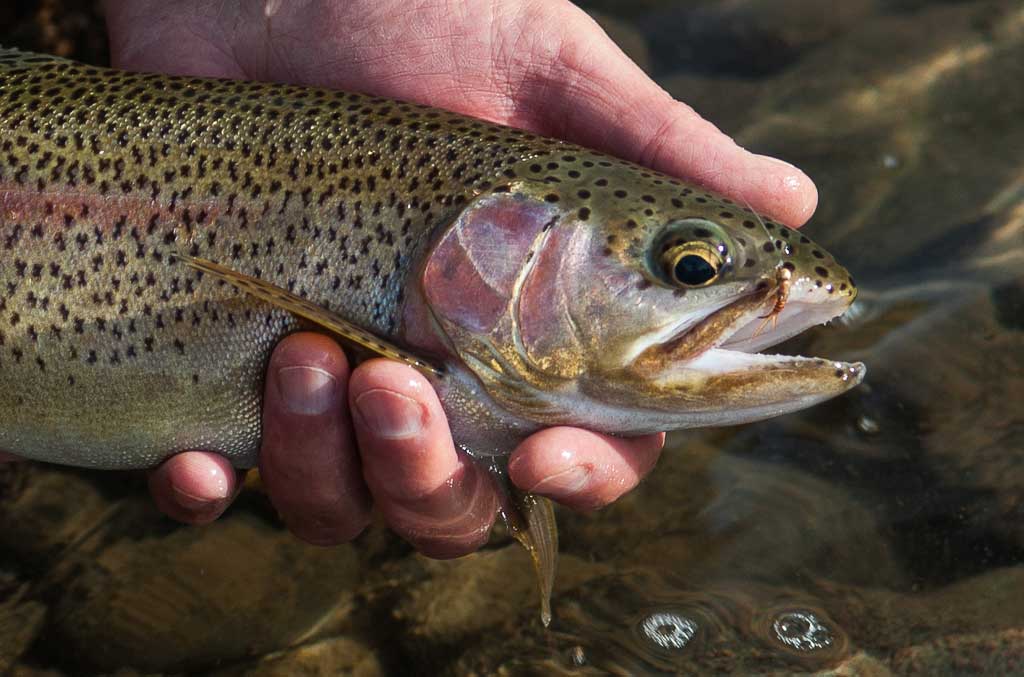Smaller and Quieter Can Be Better, Part II: No Hatch

This Yakima River rainbow went for the small Gabriel’s Trumpet nymph showing outside his jaw. Going smaller when nothing’s hatching leaves you wide open to try unnatural attractor fly patterns. Sometimes, for reasons only fish and God understand, attractor patterns can be hot—much hotter than natural patterns that imitative the feed fish actually eat. Carol Ann Morris photo
As often as tiny flies are right for matching hatches, they can be right just for fooling trout when no hatches are underway. Let’s say you can see a trout holding down close to the pale cobble bottom in a clear river. You work a big Woolly Bugger ever deeper until at last it swims up to the trout’s mouth. The fish darts to the side to avoid the fly. Did he see it? Of course he did. Do you now try an even bigger fly fished with more action? That approach would only make sense if you thought the trout couldn’t find your fly and, clearly, that’s not an issue. So you go to a Beadhead Prince Nymph on a size 10 hook, a popular pattern that imitates nothing but often works, and you hang it below an orange strike indicator and drift it up to the trout. He slides over again to let your Prince pass untouched.
Now what? You continue experimenting, of course, and in the end it’s a size-20 midge-pupa pattern as a dropper above a heavy stonefly nymph (the heavy nymph carrying down the dinky lightweight one) that finally gets the take. A happy ending then, but the point is, a midge-fly worked where other, bigger flies failed—yet there were no midges hatching.
Were midge pupae active and drifting in the current down beyond your sight? Does that explain your success? Probably not. Most likely those cautious trout just couldn’t penetrate the hoax you played on them. The quiet, tiny fly was too convincing. So little flies can often turn the trick on smart trout, hatch or no.
More than a few years ago, on a popular section of a small spring creek, I followed the ever-smaller-fly formula I described above. Those jaded trout wouldn’t touch anything. . .until I went down to a size-18 nymph as a dropper. They just couldn’t identify that tiny fly as an impostor. I hooked quite a few of them.
I’ve seen this in trout lakes, with floating flies. Once, on an air-clear catch-and-release pond (really, what is a pond but a little lake?) high in the Colorado Rockies, in the center of a small tourist town, I had to go to size 24 flies dry flies and emerger-flies and wispy 8X tippet before I started hooking the browns and rainbows that had been trained by a parade of vacationing anglers to feed with great caution. But this wasn’t about hatches—it didn’t seem to matter what fly pattern I showed these difficult fish, so long as that fly was truly miniscule. A fish would feed in a line of the tidiest dimples, I’d set the bitsy dry or emerger where the next quiet rise should come, then wait. . .wait. . . And finally, sometimes, that spec of a floating fly would go down in another dimple in the water. Of course the fish might change direction in his feeding, or miss the fly for any number of other reasons. But if a trout took anything in this rich, transparent, hard-fished water, it nearly always took something very small.
On another not-quite-lake—a two-acre, fishing-club trout pond outside Portland, Oregon—I spent my first late winter through early spring as a member showing flies to probably most of the rainbow trout in there. They were pushovers for a while, but that changed. By late spring the only consistent way to hook those fish was with a small midge-pupa fly teased deep below a strike indicator.
Another effective strategy was to throw a dry fly with a tiny nymph dangled on a foot-and-a-half or so of tippet off the bend of the dry’s hook. I saved this approach for when trout were showing at the surface to pick off the variety of feed that sometimes collected there. I’d twitch the dry fly, the trout would slip over to inspect it, would refuse it, and would then see that convincing little nymph drifting slowly downward just below it—the dry fly would disappear without anything touching it, I’d set the hook on the dinky dropper, and up an out would come a rainbow trout, angry both about the sting of the hook and about getting fooled when he thought he had us fly fishers all figured out.
Yes, that pond had its share of insect hatches, but when there were no hatches, a tiny nymph seemed to do what no other fly could: convince those cautious trout.
A fly of almost any size fished in almost any way can work at any time—that’s just a reality of fishing. But most of the time, if trout turn away from your fly, your best bet is to show them one that’s smaller, even if no little bugs are hatching.
Read “Smaller and Quieter Can Be Better, Part I: Trout Streams and Hatches”











